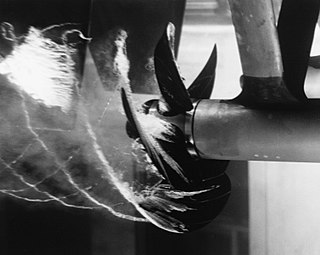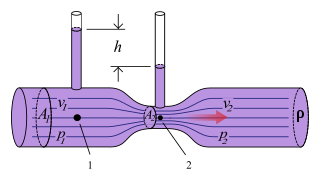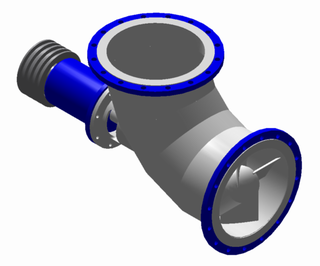
Cavitation in fluid mechanics and engineering normally refers to the phenomenon in which the static pressure of a liquid reduces to below the liquid's vapour pressure, leading to the formation of small vapor-filled cavities in the liquid. When subjected to higher pressure, these cavities, called "bubbles" or "voids", collapse and can generate shock waves that may damage machinery. These shock waves are strong when they are very close to the imploded bubble, but rapidly weaken as they propagate away from the implosion. Cavitation is a significant cause of wear in some engineering contexts. Collapsing voids that implode near to a metal surface cause cyclic stress through repeated implosion. This results in surface fatigue of the metal, causing a type of wear also called "cavitation". The most common examples of this kind of wear are to pump impellers, and bends where a sudden change in the direction of liquid occurs. Cavitation is usually divided into two classes of behavior: inertial cavitation and non-inertial cavitation.

A pump is a device that moves fluids, or sometimes slurries, by mechanical action, typically converted from electrical energy into hydraulic energy.
Airlift is the act of transporting people or cargo from point to point using aircraft.

The Venturi effect is the reduction in fluid pressure that results when a moving fluid speeds up as it flows through a constricted section of a pipe. The Venturi effect is named after its discoverer, the 18th-century Italian physicist Giovanni Battista Venturi.
A vacuum ejector, or simply ejector is a type of vacuum pump, which produces vacuum by means of the Venturi effect.

Dredging is the excavation of material from a water environment. Possible reasons for dredging include improving existing water features; reshaping land and water features to alter drainage, navigability, and commercial use; constructing dams, dikes, and other controls for streams and shorelines; and recovering valuable mineral deposits or marine life having commercial value. In all but a few situations the excavation is undertaken by a specialist floating plant, known as a dredger.
A gas lift or bubble pump is a type of pump that can raise fluid between elevations by introducing gas bubbles into a vertical outlet tube; as the bubbles rise within the tube they cause a drop in the hydrostatic pressure behind them, causing the fluid to be pulled up. Gas lifts are commonly used as artificial lifts for water or oil, using compressed air or water vapor.
In the oil industry, waterflooding or water injection is where water is injected into the oil reservoir, to maintain the pressure, or to drive oil towards the wells, and thereby increase production. Water injection wells may be located on- and offshore, to increase oil recovery from an existing reservoir.

A hose is a flexible hollow tube designed to carry fluids from one location to another. Hoses are also sometimes called pipes, or more generally tubing. The shape of a hose is usually cylindrical.

An injector is a system of ducting and nozzles used to direct the flow of a high-pressure fluid in such a way that a lower pressure fluid is entrained in the jet and carried through a duct to a region of higher pressure. It is a fluid-dynamic pump with no moving parts except a valve to control inlet flow.

An airlift is device based on a pipe, used in nautical archaeology to suck small objects, sand and mud from the sea bed and to transport the resulting debris upwards and away from its source. It is a type of suction dredge. A water dredge or water eductor may be used for the same purpose.

Centrifugal pumps are used to transport fluids by the conversion of rotational kinetic energy to the hydrodynamic energy of the fluid flow. The rotational energy typically comes from an engine or electric motor. They are a sub-class of dynamic axisymmetric work-absorbing turbomachinery. The fluid enters the pump impeller along or near to the rotating axis and is accelerated by the impeller, flowing radially outward into a diffuser or volute chamber (casing), from which it exits.

An axial-flow pump, or AFP, is a common type of pump that essentially consists of a propeller in a pipe. The propeller can be driven directly by a sealed motor in the pipe or by electric motor or petrol/diesel engines mounted to the pipe from the outside or by a right-angle drive shaft that pierces the pipe.
In a hydraulic circuit, net positive suction head (NPSH) may refer to one of two quantities in the analysis of cavitation:
- The Available NPSH (NPSHA): a measure of how close the fluid at a given point is to flashing, and so to cavitation. Technically it is the absolute pressure head minus the vapour pressure of the liquid.
- The Required NPSH (NPSHR): the head value at the suction side required to keep the fluid away from cavitating.

A water eductor or water dredge is an eductor-jet pump-based tool used by underwater archaeologists to remove sediments from an underwater archaeological site. Airlifts may be used for the same purpose.
In fluid dynamics, total dynamic head (TDH) is the work to be done by a pump, per unit weight, per unit volume of fluid. TDH is expressed as the total equivalent height that a fluid is to be pumped, taking into account friction losses in the pipe.
A rotodynamic pump is a kinetic machine in which energy is continuously imparted to the pumped fluid by means of a rotating impeller, propeller, or rotor, in contrast to a positive-displacement pump in which a fluid is moved by trapping a fixed amount of fluid and forcing the trapped volume into the pump's discharge. Examples of rotodynamic pumps include adding kinetic energy to a fluid such as by using a centrifugal pump to increase fluid velocity or pressure.
A hydraulic compressor is a means of compressing air useing hydraulic energy. There ate two very different types of machine referred to as hydraulic compessors.
High-density solids pumps are hydrostatically operating machines which displace the medium being pumped and thus create a flow.
The Glossary of Geothermal Heating and Cooling provides definitions of many terms used within the Geothermal heat pump industry. The terms in this glossary may be used by industry professionals, for education materials, and by the general public.













